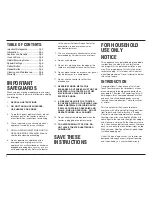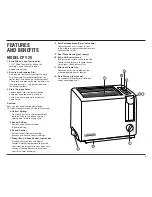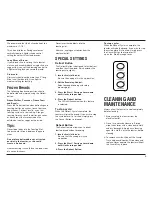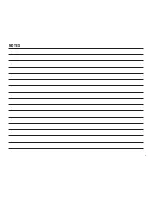
4
USE AND CARE
Unwind the power cord. Check that the
crumb tray is in place and that there is
nothing in the toaster slot. Plug power cord
into the wall outlet.
1. Insert slice(s) of bread.
Be sure that the bread carriage is in the
up position.
2. Set the Browning Control.
Turn the rotary browning dial to the
desired position. Toast gets darker as
the dial is turned clockwise from left to
right. The browning dial can be adjusted
either before or after pressing down the
Start / Carriage Lever.
There is a color band around the dial to
select the browning setting.
The browning guide is as follows:
Desired Color
Dial Position
Light
1st third of color band
Medium
2nd third of color band
Dark
Final third of color band
3. Begin Toasting.
Press the Start / Carriage Lever down until
it locks into position. The toaster will start.
4. If desired,
Select a Special Setting
on the
button control after the Start / Carriage
Lever is pushed down. If no Special
Settings are selected, the toaster will
brown your toast based on the selection
you have made on the browning dial.
If you desire a Special Setting, press one of
the following buttons:
Defrost
- for defrosting, then toasting.
Adds time to the standard toast cycle for
defrosting.
Reheat
- for reheating pretoasted bread.
When you press one of these Special
Settings, a red LED light will come on above
the selected feature button.
5. To Stop Toasting.
When the toasting cycle is finished, the
toast will be raised. If you wish to stop the
cycle before it is finished, simply press the
Cancel Button. You can also lift up the
Start / Carriage Lever to stop the cycle.
Pressing the Cancel Button will also
cancel the Special Settings.
Helpful Browning Notes:
Toasting is a combination of cooking and dry-
ing the bread. Therefore, differences in mois-
ture level from one bread to another can
result in varying toasting times.
For slightly dry bread, use a lighter setting
than you normally would.
For very fresh bread or whole wheat
bread, use a darker setting than normal.
Dense, moist breads may also require a
darker setting.
Breads with very uneven surfaces (such as
English muffins) will require a higher (darker)
browning setting.
Thickly cut pieces of bread (including bagels)
will take longer to toast, sometimes signifi-
cantly longer, since more moisture must be
evaporated from the bread before toasting
can occur. For moister breads or very thick
pieces you may need to make the toast
setting darker than you normally would.
Very thick pieces may require two cycles.
Before toasting bagels, slice into two
equal halves.
When toasting raisin breads, fruit breads,
or fruit muffins, remove any loose fruit, etc.
from the surface of the bread before placing
into the toaster. This will help prevent pieces
from falling into the toaster or sticking on the
guard wires in the slot.
A single slice of toast requires less toasting
time than two slices of bread. To prevent
overtoasting of a single slice, set the
browning control to a lighter setting than
you normally would. Each chamber is
designed for 2 slices of bread. By lowering
the toasting time for a single slice, your
bread won't get too brown.
Notes on Specialty Uses:
Toaster Pastries:
Exercise caution with toaster pastries; the
filling can become quite hot long before the
surface of the pastry becomes browned.
A lighter setting should be adequate. Never
leave toaster pastries unattended while
toasting or warming. Avoid iced pastries.
The icing can melt onto inside of toaster or
burn easily.
Muffins:
Require longer toasting time than regular
breads. Slice muffins vertically and remove
paper wrapper before toasting.
English Muffins & Thick
Sliced Breads:
Require longer toasting time than regular
breads. We suggest that you increase the
darkness setting on the browning dial to
increase the toasting time.
Summary of Contents for Cool Touch CPT-20
Page 7: ...NOTES 7...


























